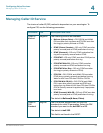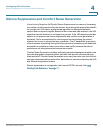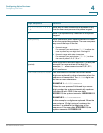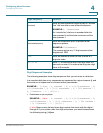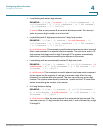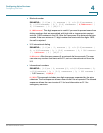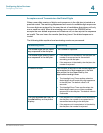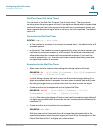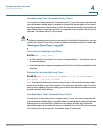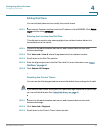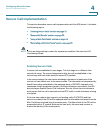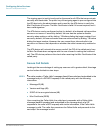
Configuring Voice Services
Configuring Dial Plans
ATA Administration Guide 66
4
Acceptance and Transmission the Dialed Digits
When a user dials a series of digits, each sequence in the dial plan is tested as a
possible match. The matching sequences form a set of candidate digit sequences.
As more digits are entered by the user, the set of candidates diminishes until only
one or none are valid. When a terminating event occurs, the SPA9000 either
accepts the user-dialed sequence and initiates a call, or else rejects the sequence
as invalid. The user hears the reorder (fast busy) tone if the dialed sequence is
invalid.
The following table explains how terminating events are processed.
Terminating Event Processing
The dialed digits do not match
any sequence in the dial plan.
The number is rejected.
The dialed digits exactly match
one sequence in the dial plan.
• If the sequence is allowed by the dial plan, the
number is accepted and is transmitted
according to the dial plan.
• If the sequence is blocked by the dial plan, the
number is rejected.
A timeout occurs. The number is rejected if the dialed digits are
not matched to a digit sequence in the dial
plan within the time specified by the
applicable interdigit timer.
• The Interdigit Long Timer applies when the
dialed digits do not match any digit sequence
in the dial plan. The default value is 10
seconds.
• The Interdigit Short Timer applies when the
dialed digits match one or more candidate
sequences in the dial plan. The default value is
3 seconds.
The user presses the # key or
the dial softkey on the phone
display.
• If the sequence is complete and is allowed by
the dial plan, the number is accepted and is
transmitted according to the dial plan.
• If the sequence is incomplete or is blocked by
the dial plan, the number is rejected.



